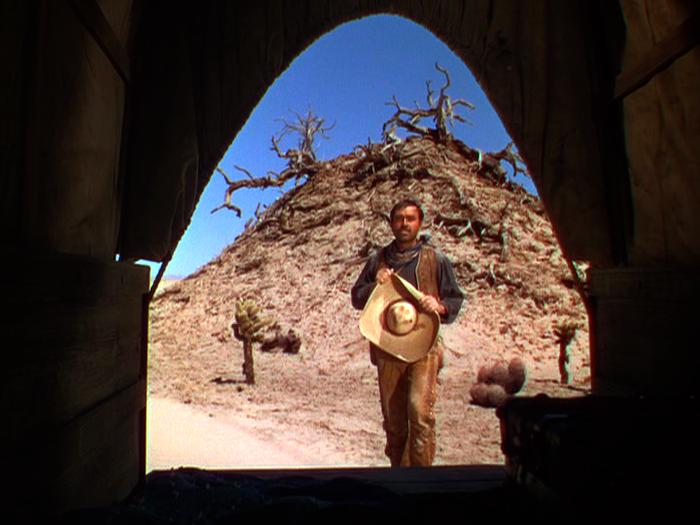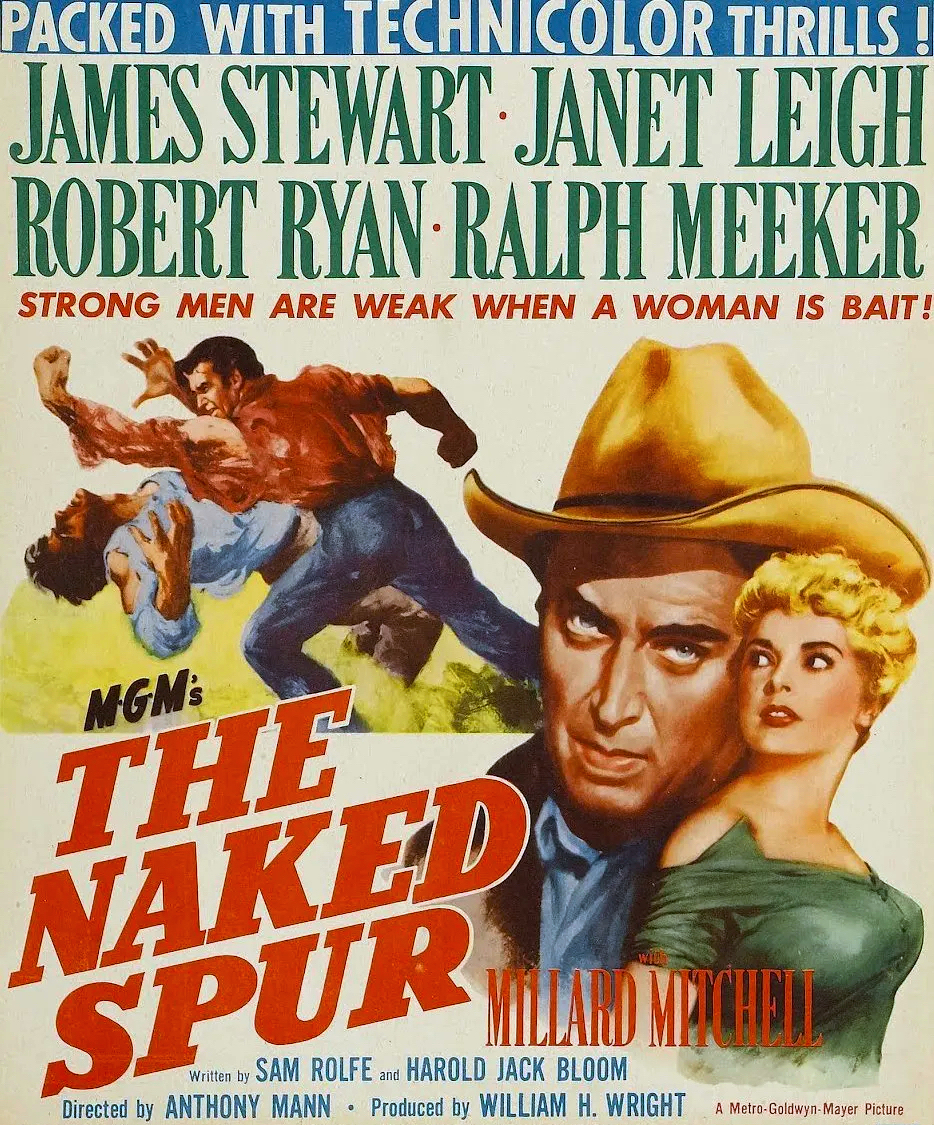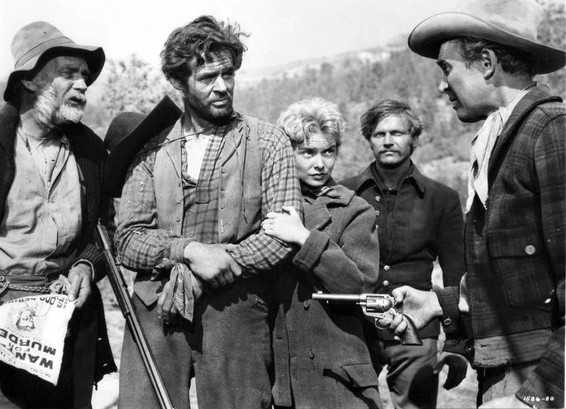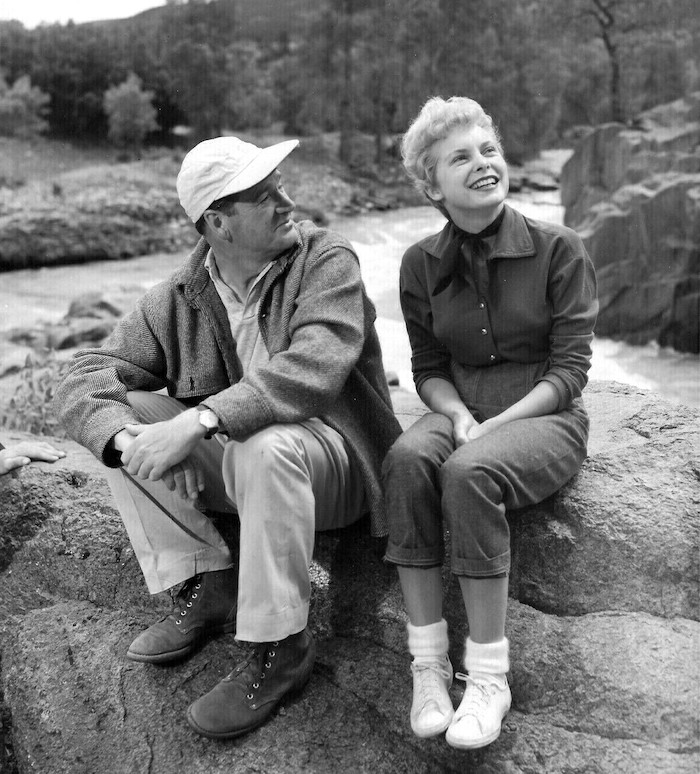
Directed by John Ford
Produced by John Ford & Merian C. Cooper
Screenplay by Laurence Stallings, Frank S. Nugent & Robert Nathan
Based on The Three Godfathers by Peter B. Kyne
Director Of Photography: Winton Hoch, ASC
Film Editor: Jack Murray
Musical Score: Richard Hageman
Cast: John Wayne (Robert Marmaduke Hightower), Pedro Armendáriz (Pedro Encarnación Escalante y Rocafuerte, AKA Pete), Harry Carey Jr. (William Kearney, The Abilene Kid), Mildred Natwick (Mother), Ward Bond (Sheriff Perley “Buck” Sweet), Mae Marsh (Mrs. Sweet), Jane Darwell (Miss Florie), Guy Kibbee (Judge), Hank Worden (Curly), Dorothy Ford (Ruby Latham), Charles Halton (Oliver Latham), Jack Pennick (Luke), Fred Libby (Deputy), Ben Johnson (Posseman), Michael Dugan (Posseman) Francis Ford (Drunken Old-Timer at Bar), Richard Hageman (Piano Player In Saloon), Ruth Clifford (Woman in Bar), Jack Curtis (Bartender), Harry Tenbrook (Bartender), Gertrude Astor (Townswoman), Eva Novak (Townswoman), Amelia Yelda (Robert William Pedro Hightower)
Why is John Ford’s 3 Godfathers (1948) so often overlooked, so rarely mentioned along with the director’s other post-war masterworks? Even called “minor Ford,” by some. Since its release in December of 1948, it’s been criticized for being too sentimental, too religious, too hokey. But as I see it, it’s just too good to ignore.
 While John Ford was shooting Fort Apache (1948), the first picture in his “cavalry trilogy,” the great silent Western star Harry Carey passed away. Ford got his start directing Carey pictures, and Ford shut down Fort Apache for a few days to visit the dying star, reminiscing with him as he breathed his last. Ford then put together Carey’s funeral, by all accounts an elaborate affair.
While John Ford was shooting Fort Apache (1948), the first picture in his “cavalry trilogy,” the great silent Western star Harry Carey passed away. Ford got his start directing Carey pictures, and Ford shut down Fort Apache for a few days to visit the dying star, reminiscing with him as he breathed his last. Ford then put together Carey’s funeral, by all accounts an elaborate affair.
For his next film, Ford chose 3 Godfathers, based on a Peter B. Kyne novelette he’d filmed with Harry Carey back in 1919 as Marked Men. (It’s a lost film.) Ford decided to “introduce” Harry Carey, Jr. with the remake, even though the young actor had already done a few pictures, including appearing with his dad in Howard Hawks’ Red River (1948). Ford also needed a hit after the failure of The Fugitive (1947), which had put his Argosy Productions in real trouble. A Technicolor Western with John Wayne oughta do the trick.
3 Godfathers opens with a silhouetted figure on horseback, Cliff Lyons sitting on Harry Carey’s horse Sonny, and the dedication:
“To the Memory of Harry Carey —
Bright Star of the early western sky…”

After robbing a bank in Welcome, Arizona, three outlaws — John Wayne, Pedro Armendáriz and Harry Carey Jr. — are pursued into the desert by a posse lead by Sheriff Buck Sweet (Ward Bond). Out of water, Carey wounded and their horses lost in a sandstorm, the outlaws come across a pregnant woman (Mildred Natwick) at Terrapin Tanks. Her tenderfoot husband took off in search of water, after blowing up the tanks, leaving her alone and ready to give birth.

Pedro (Armendáriz) helps deliver the baby, and before the mother dies, she names the boy after its three godfathers (Robert William Pedro Hightower) and asks them to save her baby. They promise. After burying the mother, the outlaws discover a trunk full of things she had packed for her new baby, including some canned milk and a Bible. They pack a few things and head out.
Here, Ford begins to bring in the religious allegory, as the three bad men (not wise men, not kings) follow a star toward New Jerusalem with the newborn.

William Kearney, “The Abilene Kid” (Harry Carey, Jr.): “You fellas don’t understand. Ya think this is just chance? Just accidental like, us coming here this way? Finding the mother. Helping her. The infant in the manger. The star, bright, last night. I ain’t talking out of no fever sweat, Bob, honest I ain’t. You think we had anything to do with what’s happened? No sir, we didn’t.”
(Beware: spoilers ahead.) Of course, the desert is unforgiving, and two of the outlaws don’t finish the journey. Kearney eventually succumbs to his woulds. Pete falls and breaks his leg — and encourages Bob (Wayne) to head on alone with the child. Pete asks for Wayne’s pistol, in case of coyotes.
Pedro “Pete’ Roca Fuerte (Pedro Armendáriz): “Hey, Bob… I just remembered what tomorrow is. Feliz Navidad. Merry Christmas.”
It’s not long after Wayne trudges on that we hear the shot.

Wayne on location. (If only they’d had that film truck in the movie!)
As Wayne continues toward New Jerusalem with the baby, thirst and exhaustion (and his lack of faith) take their toll and he comes close to giving up — even after the ghosts of his friends urge him to keep going. Wayne falls to the ground, and the Bible is blown open to Matthew 21 —
“As they approached Jerusalem and came to Bethphage on the Mount of Olives, Jesus sent two disciples, saying to them, ‘Go to the village ahead of you, and at once you will find a donkey tied there, with her colt by her. Untie them and bring them to me. If anyone says anything to you, say that the Lord needs them, and he will send them right away.’” (Matthew 21:1-3, NIV)
Wayne reads of God’s provision of a donkey and its colt — and those very animals appear to help Wayne and the child complete their pilgrimage. Wayne’s reaction to the miracle is shock, disbelief and perhaps a sudden awakening. (Wayne plays it so well.) Bob and the baby reach a saloon in New Jerusalem early Christmas morning. The saloon’s piano player (Richard Hageman, who scored the film) plays “Silent Night.”

Sheriff Sweet enters the saloon, Winchester at the ready. Wayne collapses, muttering “You got me!” as he falls to the floor. (Who got him, the sheriff or the Lord?)
Now we get to see Bob’s true redemption — he’d rather do time than sign the adoption papers for a suspended sentence. They’d made a promise to a dying woman. As Bob boards the train, bound for a year and a day in the prison in Yuma, he has Bond and his wife to care for the child and a girl (Dorothy Ford) waiting for him when he’s released. It’s a joyous time, as far from any other heading-to-the-penitentiary scene as you can get.
(That’s a more in-depth synopsis than I normally like to include. Seemed necessary.)

One of the incredible things about John Ford’s work is his ability to make his movies turn on a dime. He can shift tone from scene to scene — and the picture works. With other directors, you’re left with a disjointed film that doesn’t know what it wants to be and the audience doesn’t know what to make of it. Here, Ford takes us from the jovial chat with the sheriff before the robbery to the suspense of the chase and the sandstorm to the drama of the discovery of the wagon, the baby’s birth and the mother’s death to the comedy of the three godfathers trying to figure out how to care for the baby (above) — and on to the journey through the desert with its tragedy, sacrifice and spiritual awakening. Never are these shifts jarring. It flows seamlessly.
Also, Ford never lets us see the bad side of the three bad men. From the friendly chat with the Sweets to Bob and Pete refusing water to save it for the wounded Kid to Pete’s treatment of the expectant mother to their oath to her as she dies, we are instead shown their goodness. (The bank robbery takes place offscreen.) We’re set up to like them, to pull for them, to celebrate their redemption and eventually mourn their loss.

Harry Carey, Jr., nicknamed Dobe (comparing his red hair to adobe), recalled, “We shot 3 Godfathers in Death Valley. It was in May, and that’s a beautiful time of year up there. We stayed at The Furnace Creek Inn, and Uncle Jack was in seventh heaven. He was off on location with no front-office types to look over his shoulder, and he had both Pete Armendáriz and Ward Bond to pick on.”* (The Furnace Creek Inn hosted many film crews over the years, ranging from One-Eyed Jacks to Star Wars.)
Nights in Death Valley were spent playing dominos.

Ward Bond was Ford’s favorite target for abuse, and the rest of the cast and crew breathed easier when he was around. Pedro Armendáriz, a big star in Mexico — who’d been in Ford’s two previous pictures, The Fugitive and Fort Apache (1947), was another of Ford’s favorite victims. Armendáriz reported for 3 Godfathers with an ornate black leather, silver-studded costume complete with a large sombrero. Ford promptly set him straight — he was no hero in the picture, just a bandit — and he was issued a beat-up outfit to match his character. Armendáriz was furious, especially when he saw the swayback horse and worn-out Mexican saddle he was to use. The more Armendáriz complained, the more junk Ford took from the prop truck (frying pan, coffee pot, etc.) and hung on the great Mexican star’s saddle.
Temperatures in Death Valley reached 130 degrees some days. “It was a terrible location, with the sand and the dirt,” Ben Johnson once commented.** Johnson’s role, as a member of the posse, is quite small — Ford was evidently still feeling him out as an actor.

For the Kid’s death scene, the first take didn’t meet Ford’s approval, to put it mildly. Ford had the cast and crew clear out, leaving Dobe laying alone in the sun — no shade, no water — for half an hour. When they returned, take two was all that was needed. It was real. As Carey remembered in his book Company Of Heroes, “Duke lifted me to my feet. He had his arms around me, holding me up. Ford took my face in his hands. He was smiling. ‘Why didn’t you do that the first time? See how easy it was? You done good! That’s a wrap!'”
After Death Valley, it took about 10 days at the RKO Pathé studio to finish shooting 3 Godfathers. Mildred Natwick’s scene as the dying mother was shot there one morning, then they had lunch in Ford’s office. The dedication to Harry Carey that opens the picture was the last thing done.

3 Godfathers was cinematographer Winton C. Hoch’s first film with Ford. Together, they made some of the most beautiful Westerns ever, with Hoch winning an Oscar for She Wore A Yellow Ribbon (1949). But 3 Godfathers has one gorgeous, breathtaking image after another, like a great Western painting that moves.
Richard Hageman makes good use of a number of familiar tunes, which he brings in and out of his score with ease. Ford’s films almost always use songs the audience knows. “Goodbye Old Paint” is heard during the Harry Carey tribute. The Kid sings “Streets Of Laredo (The Dying Cowboy),” the townspeople sing “Bringing In The Sheaves,” and this being a John Ford movie, you can count on “Shall We Gather At The River.”
Redemption is probably the most common theme in Westerns, and it’s every bit as important to 3 Godfathers as the parallels to the Christ child are. So it’s fitting that Ford set things in the days leading to Christmas, a time of renewal.
Harry Carey, Jr. again: “There was a very special feeling on every John Ford set. It was the feeling that something great was happening, a feeling of reverence. It wasn’t a feeling of reverence for John Ford; it was a feeling of reverence for art. It was like being in church.”*
How someone could sit through the picture’s 106 minutes and not be moved (if not choked up) is beyond me. It rewards repeat viewings by revealing more and more, like peeling back one layer after another, making it a gift we can unwrap each and every Christmas.
Minor Ford? That’s ridiculous.
* Pappy: The Life Of John Ford by Dan Ford
** John Ford: Hollywood’s Old Master by Ronald L. Davis
Be sure to read the chapter on 3 Godfathers in Harry Carey, Jr.’s book Company Of Heroes
Thanks to Pastor James of The Narrow Trail Cowboy Church
Read Full Post »

























